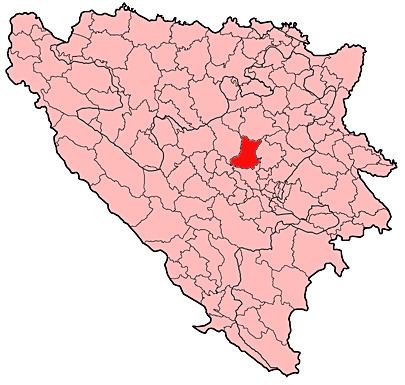Time zone CET (UTC+1) Area code(s) +387 32 Local time Friday 10:22 PM | Postal code 72,240 Area 377 km² | |
 | ||
Weather 4°C, Wind SE at 8 km/h, 74% Humidity Clubs and Teams FK Rudar Kakanj, FK Mladost Doboj Kakanj | ||
Kakanj is an industrial town and a municipality in central Bosnia and Herzegovina, located north of Visoko and southeast of Zenica. It was built along the slopes of wide hills on either side of the Zgošća river. It is administratively part of the Zenica-Doboj Canton of the Federation of Bosnia and Herzegovina.
Contents
- Map of Kakanj Bosnia and Herzegovina
- Demographics
- History
- Bosnian War 1992 95
- Post war
- Sport
- Villages in the municipality 1991
- Ethnic structure by settlements 1991 census
- Notable people
- References
Map of Kakanj, Bosnia and Herzegovina
Demographics
In the census of 1991, the city of Kakanj itself had 12,008 inhabitants.
In 2005, estimates of population of the municipality included 88% Bosniaks and 11% Croats.
History
Neolithic artifacts have been found in Obre, a nearby village.
Settlements in the region are very ancient. They are claimed to be historical landmarks of the early Bosnian state. Kraljeva Sutjeska, a Franciscan monastery, is of particular historical note. Near the monastery is Bobovac, scene of the last stand of Bosnian Queen Katarina Kosača and medieval residence of Bosnian kings. In Kraljeva Sutjeska is one of the oldest mosques in Bosnia, built by order of Sultan Mehmed II the Victorious during his expedition to Bosnia and conquest of Bobovac. The Kakanj area enjoyed a renaissance during the rule of the Kotromanić dynasty.
One of the most beautiful tombs ever found in Bosnia, with a carving of a hunting cavalier, was found in Kakanj; it is currently displayed in the botanic garden of The State Museum in Sarajevo.
Kakanj was first mentioned 1468 as settlement with 90 houses. Coal mine Kakanj was founded in 1900 under Austro-Hungarian rule around a developing coal mine, which began production in 1902. In the next hundred years, Kakanj developed organically without any urban planning, initially around the coal mine, and later along the banks of the Zgošća and Bosna rivers.
Bosnian War (1992-95)
The situation in Kakanj at the beginning of the Bosnian War was rather quiet, confronted with the frontlines in the area of Zavidovići. The town was in the middle of the Bosniak Sarajevo-controlled territory, along the communication path with Zenica. Most of the Serb minority soon left the town, while Bosniak refugees from Serb-controlled towns returned.
Between March and June 1994, Croats and Bosniaks signed the Washington Agreement, forming the Federation of Bosnia-Herzegovina. The situation in Kakanj improved, but refugees did not came back. Health and sanitation conditions are poor, even though not severe; an hepatitis epidemic is recorded in 1994. Food Security is under control, thanks to humanitarian aid, even though prices remain prohibitive and most of the family survive with company-organized distribution and kitchen gardens. Almost all productive activities are stopped, and nobody receive any salary, but monthly food packages.
Post-war
After the war the population of Kakanj rose to 48,000, of which 43,000 are Bosniaks, 4,000 are Croats, and few hundreds are Serbs. From 1995 to 1998, some hundred Croats made individual returns to Kakanj, and 3,000 Bosniak refugees returned to their homes.
The economy in Kakanj, notwithstanding promises, does not start off, and many young people leave or do not come back from gastarbeiter workplaces in Germany and elsewhere. Over 16,000 town inhabitants, more than 4,000 are unemployed. The cement factory (owned by a German company by 51%) does not work fully, and all the cement goes for construction works in Sarajevo. The coal mine hardly works: its coal is out of market because it's polluting. Cement factory workers earns the most, 800 DM/months; then came powerplant workers, and last the miners. The cost of life for a 4 persons family is around 1000 DM/month.
On 29 Septembre 1999, the High Representative (OHR) Wolfgang Petrisch removed from office the mayor of Kakanj, Kemal Brodilija, for obstructing the implementation of the Dayton Agreements and pursuing an extra-legal agenda.
Sport
Villages in the municipality (1991)
The name "Kakanj" also refers to one of the many villages in the municipality: Alagići • Bastašići • Bašići • Bičer • Bijele Vode • Bijelo Polje • Bilješevo • Bistrik – Crkvenjak • Bištrani • Bjelavići • Bosna • Brežani • Brnj • Brnjic • Bukovlje • Crnač • Čatići • Danci • Desetnik • Doboj • Donja Papratnica • Donji Banjevac • Donji Kakanj • Donji Lučani • Dračići • Drijen • Dubovo Brdo • Dumanac • Gora • Gornja Papratnica • Gornji Banjevac • Gornji Lučani • Govedovići • Gradac • Groce • Halinovići • Haljinići • Hausovići • Hodžići • Hrasno • Hrastovac • Ivnica • Javor • Jehovina • Jerevice • Jezero • Kakanj • Karaula • Karaulsko Polje • Klanac • Kondžilo • Koprivnica • Kraljevska Sutjeska • Krševac • Kučići • Kujavče • Lipnica • Lučići • Lukovo Brdo • Marijina Voda • Miljačići • Mioči • Modrinje • Mramor • Nažbilj • Obre • Papratno • Pavlovići • Pedići • Podbjelavići • Podborje • Poljani • Poljice • Pope • Popržena Gora • Ratanj • Ribnica • Ričica • Rojin Potok • Saranovići • Sebinje • Semetiš • Seoce • Slagoščići • Slapnica • Slivanj • Slivnice • Sopotnica • Starposle • Subotinje • Termoelektrana • Teševo • Tičići • Tršće • Turalići • Turbići • Varalići • Veliki Trnovci • Viduša • Vrtlište • Vukanovići • Zagrađe • Zgošća • Zlokuće • Željeznička Stanica Kakanj • Živalji.
Ethnic structure by settlements, 1991 census
Absolute ethnic majority:
Relative ethnic majority:
